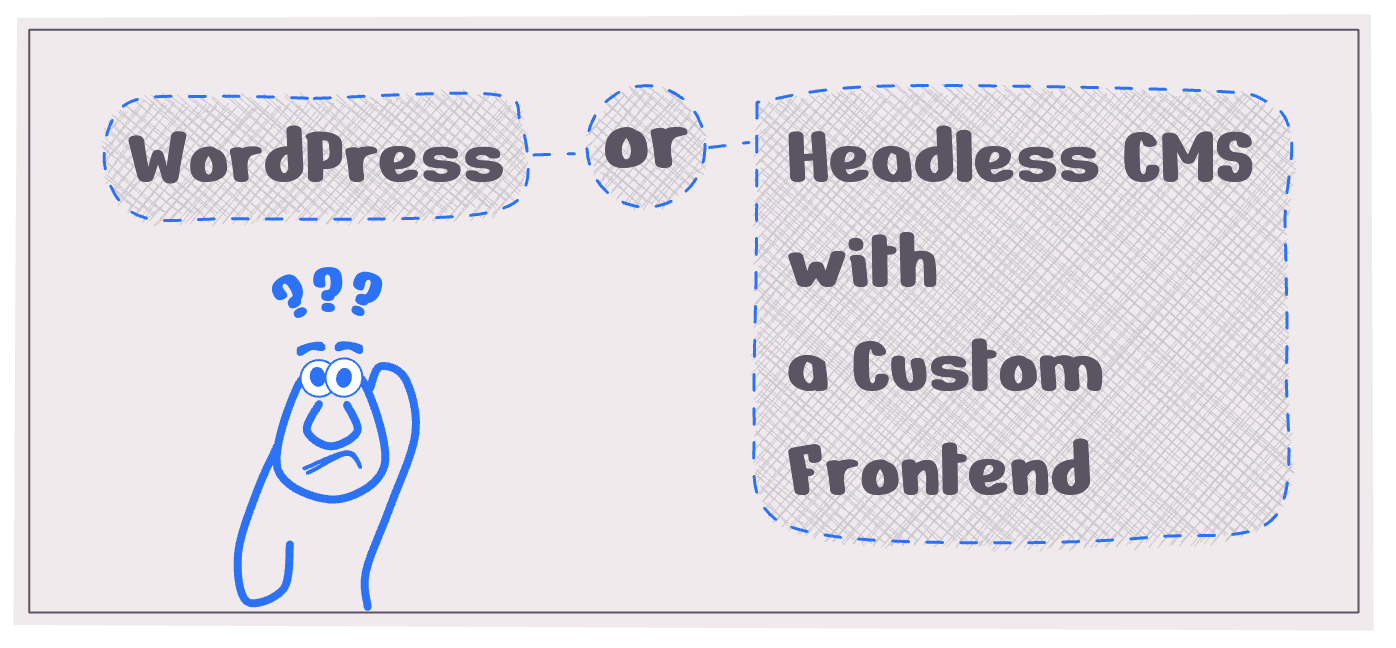WordPress vs Headless CMS with a custom frontend : What is a better choice?

While building content management setups, I often get to interact with folks from the content or marketing teams. And, they frequently express their frustration with regard to the time it takes for the tech teams to churn out new features. During such conversations, they express how a headless content management system with a custom frontend is a step back from a mature no-code website builder like WordPress where they could simply install a new plugin for any kind of new feature that they would desire and instantly get going from there. This post is my perspective on this comparison that has evolved from such discussions.
Also, what starts as a WordPress vs Headless CMS is actually a comparison of two distinct approaches - no-code website builders with an integrated CMS vs custom-coded websites with a headless CMS.
Why marketers love WordPress (or, no code website builders)
Marketers frequently come up with new ideas around the content they publish. And, they love quick feedback (well, who doesn’t?). They hate going to a different team and being told they’ll have to wait for a few days / weeks before they can see their ideas in action. No-code builders allow them to instantly see their plans in action. Doing away with depending on a developer to code-up their ideas is a drool-worthy advantage for any non-tech personnel.
While the primary lever for marketers to prefer page builder tools like WordPress, Webflow, Wix, Carrd is the absolute control they can have, the large plugin ecosystem for these page-builders helps serve their purpose even further. With these plugins, the non-tech personnel can go quite far with implementing their ideas without needing a developer.
Why developers love custom frontends with headless backends
While page-builder tools & plugins help superfast implementation of ideas, they come with their own limitations and fragilities:
- Some plugins may not be readily customizable to suit the requirements. Tweaking them may cause security / performance issues.
- Plugins may not always work well with each other. For example - An image carousel plugin may not behave as expected on a WordPress site that uses a certain CSS optimization plugin.
Handling the above scenarios often involves wrangling around the limitations of the page-builder tools or the plugins. For example, the plugins compatibility issue mentioned above may require us to give-up on CSS optimization or override the code for one of the two conflicting plugins.
In contrast to the above, building a custom frontend enables the developers to build with greater control and operate under fewer constraints. As a result, developers can build better websites tailored specifically to the business need.
When to use what
Clearly, none of the two approaches compared here are better than the other at all times. I agree that “it depends” is an annoying answer. But, it also is the most accurate answer here. So, we need to understand the factors that matter in knowing when one approach is better than the other:
When WordPress makes better sense
WordPress, or no-code page-builder tools, work well when any of the following are true:
- Quick feedback is the topmost priority.
- The team is small and doesn’t have substantial tech experience or expertise.
- The requirements are simple.
- The budget is limited.
In-fact, with WordPress’s vast and mature plugin ecosystem, a team may end up with a better website & publishing workflow than the same with inexperienced developers custom-coding it. For example - the WordPress SEO plugins may do a better job at setting up default SEO meta-tags than an inexperienced developer.
So, a team with limited tech expertise or simple requirements is almost always better off with a WordPress based setup than a custom in-house solution.
When to opt for a headless CMS with a custom frontend
A headless CMS paired with a custom frontend suits better when:
- The requirement or the setup is complicated.
- Aspects like high-interactivity, security, scalability need to be prioritized.
- Adequate tech expertise, budget and time is available.
Complicated setup or requirement
For websites that seek to deal with data fetched from multiple sources, a headless CMS with a custom-built frontend may be necessary. Some examples of such websites - a restaurant listing platform, a flight-price tracker, etc. For such websites, some content (e.g.: blog posts, landing pages) may be fetched from a headless CMS while the rest may be sourced from elsewhere (e.g.: flights-price data feed).
Security, scalability & performance
WordPress is secure, scalable and performant out-of-the-box. But, the ease with which anyone, without tech expertise, can extend their WordPress site’s capabilities via plugins also has a down-side. Any of these plugins can negatively affect the security, scalability or performance of the site without the non-tech-expert website owners realizing the same.
Custom frontends with headless CMS have a better chance at being secure, scalable and performant if a seasoned tech-person is involved in implementing the changes.
Rich Interactivity
Websites that seek to build app-like rich interactivity experiences (e.g. - move across the site without full-page-reloads) have to be built with modern frontend frameworks like React, Vue or Angular. So, if rich-interactivity is a must-have requirement, a headless CMS with a custom frontend would be a better fit.
Availability of tech expertise, budget and time
A custom frontend with a headless CMS demands tech expertise, adequate budget and time to implement. If any of these aren’t adequately available, a custom-built CMS setup can potentially yield an outcome worse than a WordPress based solution. So, if adequate expertise, budget or time aren’t available, it is ideal to cut-down on the requirements and start with a WordPress based solution.
Conclusion
All things said and done, here’s a decent summary of the considerations:
- If quick feedback is the topmost priority:
- A no-code setup would enable fast changes, quick experimentation and early feedback.
- When prioritizing fast turnaround, you may be required to give-up on some benefits that a tailor-made solution offers.
- If your setup and requirements are simple:
- A WordPress (or an equivalent no-code platform) based solution works better.
- With a no-code setup, it is vital to keep the customizations & plugins to a minimal possible. This is so because every customization can cause us to lose on flexibility, security, scalability, performance.
- If your setup and requirements are complicated:
- A custom solution will work better for your setup only if you have adequate tech-expertise, budget and time at hand.
- If you are limited on tech-expertise, budget or time at hand - it is ideal to prune the requirements and start with a WordPress based setup.

Back in 2017, I started working as an independent web performance specialist for React frontends. Over the years, a few of the teams where I worked for long were kind enough to let me help solve their CMS issues.
Fast forward to now, I have worked with multiple teams to choose the right CMS framework and then setup + implement the chosen solution.
To discuss your CMS specific pain points, email me at punit@tezify.com.